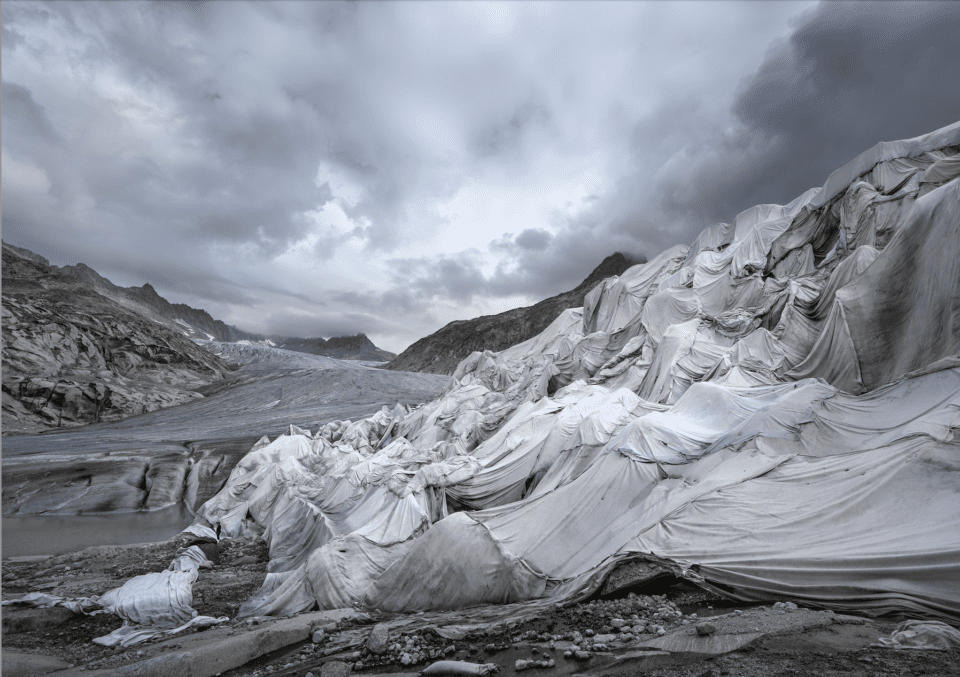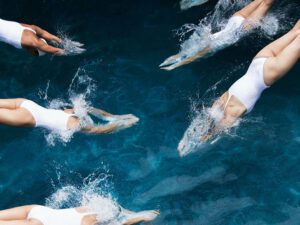“Generally, in the summer I take photographs and in the winter I work on the post-production,” says German photographer Thomas Wrede (b. 1963). “But for the first time, when I got to the computer, I didn’t feel good sitting in front of my screen, and it was because of what I was seeing.” Wrede is discussing the Glaciers project, currently on display as part of the Vienna Biennale, comprising images of the Rhône Glacier in Belvédère, Switzerland. The glacier has retreated by about 150m between 2011 and 2016. It is now partially covered in white fleece blankets, which are there as an attempt to stop the melt and arrest the decline by reflecting the sun and holding in the cold. Delicately draped and sculptural, these materials have a certain beauty, but they’re also dirty and ripped; at best they’re a sticking plaster solution to a much deeper problem, and at worst they’re introducing a whole new issue by releasing micro-plastics into the environment.
“It’s a very dark situation,” says Wrede. “The glacier is dying.” Wrede first photographed the Rhône Glacier in 2017, keen to show the effects of temperature change in Europe, when images of melting were still largely reserved for “faraway” landscapes; the idea still so distanced that western audiences would not sit up and take notice. Fast-forward four years and the effects are only too evident everywhere, and so pronounced that Wrede has already missed some planned shots at Belvédère. “I started the series shooting these very grey photographs, so this summer I wanted to go back and show the opposite,” he says. “But it’s disappeared. I’m too late.”
Glaciers have long been a source of fascination, a popular subject for Romantic writers and artists in the early 19th century – from the paintings of JMW Turner to the prose of John Ruskin – and has attracted mass tourism in the centuries that followed. The glacier at Belvédère, for example, has had additional appeal since 1870. The Carlen family – who own the iconic Belvédère Hotel on the Furka Pass (with cinematic cameos in the likes of Goldfinger) – have carved a grotto deep into the ice, creating a 100-metre long tunnel that glows in a transfixing shade of blue. The Carlens were also responsible for introducing the blankets – an act that speaks of nurturing, but is underpinned by sharp business sense; each visitor pays nine euros to visit the grotto.
It sounds hard-nosed but, as Wrede points out, the Carlens are far from alone. The Alps are a “big construction project.” Entire communities are supported by its tourism, sports and the complicated architecture that makes it all possible. How- ever, it’s all being undermined, and fast. Chair lifts that escort passengers up and down the mountains are embedded in permafrost that’s melting; the foundations are literally being shook. The lifts in question then lead to restaurants whose once-solid footing now seems tenuous. In 2012, the WWF recorded 120 million tourists in the Alps each year. As Wrede points out, the businesses that cater to them “put so much money into this industry that they want to keep it.” Temperature rise means they’re having to invest in more resources, in a kind of self-perpetuating trap or vicious cycle. In future, the Carlens will have to dig the grotto deeper into the Earth.
For Wrede, this corporate approach speaks to our entire perception of the environment, that “rather than working with nature, we see it as a resource.” And this is how many cultures look at the planet (predominantly in the western world, of course). One of Wrede’s early projects, Samso (1991-1995), depicts abandoned plastic sheeting used by Danish potato farmers. The sheeting has been used for years promote crop growth, and, in the 1980s and 1990s, it was buried in land- fills after it had been discarded. It’s now being uncovered slowly by the elements. In the photographs, swaths of white material tangles itself with the landscape, bleak and ghostly.
In his later pieces, Wrede points to the notion of the “sublime” – the idea that, far from being able to exploit and con- trol the world, humans will always be faced with forces much bigger than themselves. “In one of my triptychs, for example, you can see people, very tiny, in one of the panels. Just as with old paintings, we see the relationship from its relative size.” It’s easy to see why the triptych has been included in CLIMATE CARE: Reimagining Shared Planetary Futures at the Museum of Applied Arts, Vienna (MAK), and a main contri- bution to the Vienna Biennale for Change. This exhibition hopes to “inspire a new relationship with the planet,” explains Biennale curator Marlies Wirth, “one that embraces a caring position towards all species, moving away from human exceptionalism.
The arts can help us take a more-than-human perspective. Wrede’s series is a perfect example of this, evoking a sense of empathy whilst documenting the relative ‘smallness’ of humans in relation to geological forms.” Human exceptionalism, an idea also sometimes evoked by the terms humanocentrism or anthropocentrism, assumes that humans are the central or most important entity in the universe. It’s a major concept within environmental ethics and philosophy, as it is now often considered to be the root cause of manmade ecological problems. Human exceptionalism is said to underpin the concept that the planet is something to be consumed and, by suggesting other viewpoints and perspectives, art can destabilise this philosophy. It’s appropriate, then, that CLIMATE CARE is a group show, enabling viewers to manifest a “more-than-human perspective” quite literally through various projects. Wirth continues: “These artists help to convey the relevance of a biocentric – as opposed to anthropocentric – worldview, by activating collective imagination and promoting the idea of a planetary community through a shift of proportions and power structures.”

This approach underpins the entire Vienna Biennale this year. Subtitled PLANET LOVE: Climate Care in the Digital Age, it combines work by artists, designers and architects to both demonstrate the effects of global heating and suggest differ- ent approaches for alternative futures – timelines where we slow the damage and rediscover ancient practices. A public sculpture placed in Vienna’s Karlsplatz, titled Collective Action Viewer, created by Verena Tscherner and Joerg Auzinger, helps viewers to understand how climate change will impact their lives by allowing them to watch a virtual flood sweep over the Karlsplatz square via an adapted telescope.
Meanwhile, EAT LOVE: Tomorrow’s Food and Food Spaces, a joint initiative between the MAK and the Vienna Business Agency, analyses the entire food cycle, highlighting sustainable solutions to our diets, shopping habits and food produc- tion. Under the motto “Let’s talk food” the work moves from the fields to the shops and, finally, to our plates – exploring how urban food supplies might look in future. It takes the form of a prototype petrol station in a post-fossil fuel age. Meanwhile, an immersive installation by SUPERFLUX, titled Invocation for Hope, transports visitors into a future in which human beings are no longer the focus. The immersive installation includes an oasis set in a sparse forest of blackened trees. It builds on environmental philosopher Timothy Morton’s consideration of the climate crisis as a “Hyperobject” – a phenomenon of such spatial and temporal scale that it is beyond the capacity of the human mind to fully grasp it.
SUPERFLUX notes: “After travelling through a grid-like forest of burnt and blackened pines – the unexpectedly graceful skeletons of a former time – you find, at its heart, a resurgent living forest, in which multiple species are in harmony with humanity, offering a promise of a new way of living. In this cradle of biodiversity, you come to a freshwater pool, which reflects, not your own face, but another creature – a bison, an otter, a bird of prey – coming to the water to drink.”
In every edition of the Vienna Biennale – be it focused on automation and the future of human labour, artificial intel- ligence or climate care – the event encourages literacy and agency around the big challenges of the present and near-future. It’s an interesting context for Wrede’s work given that, as a photographer, his pieces are rooted in the present, not the future. Each image is a line in the sand, a statement which can impress upon viewers how bleak the situation is already.
Of course, as with all photographs, there is an agenda. Wrede’s Rhône Glacier triptych looks particularly apocalyptic at the Biennale, for example, shot as sterile grey compositions in order to provoke an emotional response of desolation and emptiness. Other images from Wrede’s Glacier series, including Blutschnee (2020), depict red snow, which is caused by a species of algae. This phenomenon is naturally occurring but can also increase glacier melt, both by creating “sun cups” and by darkening snow; Wrede hopes that these images will provoke a visceral reaction in the viewer, “the feeling that the environment could be a body.”And if he intends to move people, it’s working. “When I first showed this work in Berlin, the images made audiences very angry,” he says. “It’s a provocation, not documentation. I think of it as in-between fiction and reality, though I didn’t do much post-production. I didn’t have to change much because the world there is so crazy.”
However, by highlighting the futility of a “quick-fix solution,” Wrede manages to capture both the landscape and humanity’s extensive and damaging hubris. He succeeds in showing both the worlds that humans have created and the perspectives that have shaped them – what’s out there and the fantasies and desires that have become embedded under the surface. This is true of Wrede’s other projects, which include Manhattan Picture Worlds (2002-2007). Here, New York streets are shown with illusions of large-scale advertising billboards. Meanwhile, Magic Worlds (1997-1998) includes a strange mix of the real and fantastical at amusement parks; or Real Landscapes (2004-present), which disrupts our sense of scale by making model constructions seem “life-size.”
Ultimately, the Glaciers project is optimistic through its absurdity. We know that things are currently going one way, but this always has the potential to change. This is evident when staring melting ice in the face. Where the Vienna Biennale asserts that tackling the crisis requires a new perspective, Wrede’s photography sets the precedent for a brand-new type of thinking altogether. Ultimately, wrapping glaciers in blankets won’t save the ice, and a piece of art won’t stop the planet from warming. Photography can’t change global policy, but, crucially, it can spark a shift in consciousness. “The only solution is to change our whole idea of life,” Wrede concludes.
Words: Diane Smyth
CLIMATE CARE, Vienna Biennale for Change 2021 Until 3 October
viennabiennale.org thomas-wrede.de
Image Credits: 1. Thomas Wrede, Rhone Glacier, Ice Cave #1 (2019). 150 x 100 cm. Courtesy of Beck & Eggeling.
2. Thomas Wrede, Rhone Glacier_outside #4 (2019). 150 x 100 cm. Courtesy of Beck & Eggeling.
3. Thomas Wrede, Rhone Glacier #4, 220 x 170 cm (detail) (2020). Courtesy of Beck & Eggeling.
4. Thomas Wrede, Rhone Glacier #2, (2018). Middle part of a triptych, 120 x 390 cm, courtesy of Beck & Eggeling.
5. Thomas Wrede, Rhone Glacier_inside #6, (2019). 150 x 100 cm. Courtesy of Beck & Eggeling.
6.Thomas Wrede, Rhone Glacier, Ice Cave #1 (2019). 150 x 100 cm. Courtesy of Beck & Eggeling.









